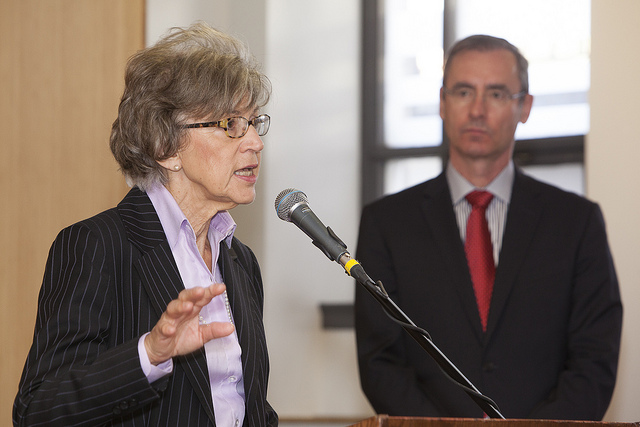Please support our coverage of democratic movements and become a monthly supporter of rabble.ca.
On June 26, 2014, in a unanimous decision of the Supreme Court of Canada, Chief Justice Beverley McLachlin gave the First Nations (and the rest of Canada) a treasure map.
It wasn’t a crumpled piece of paper covered with a cryptic scrawl, but a comprehensive legal analysis that defines the elements of Aboriginal title to land and sets out how the federal and provincial governments must act if they intend to intrude on Aboriginal lands.
And here’s the best part. By forcing the government and industry to respect Aboriginal title to ancestral lands the Supreme Court of Canada reined in the government’s relentless drive for economic development at the expense of practically everything else.
Not only does “X” mark the spot, it marks the sweet spot where a strong economy can be balanced with respect for the environment and concern for Aboriginal (and non-Aboriginal) society.
The lawsuit
The Tsilhqot’in Nation is a semi-nomadic group of bands living in central B.C. They objected to the B.C. government granting timber licences on their ancestral lands. They were unable to resolve their dispute and launched a lawsuit against the B.C. and federal government.
A number of provincial governments, First Nations and business organizations piled on, including the B.C. Business Council, which represents the forestry and mining industry. It argued that granting the Tsilhqot’in Aboriginal title to the area would have devastating economic consequences.
Thirty-one years later (!) Chief Justice McLachlin granted the Tsilhqot’in Aboriginal title over their traditional lands.
First principles
The Court went back to first principles in its review of Aboriginal title, starting with the not-so-gentle reminder that contrary to what some people may think, the doctrine ofterra nullius (that no one owned the land before the Europeans got here) does not apply in Canada.**
Having put the “how dare they” crowd to rest, the Court described the elements of Aboriginal title and what that requires from the government.
Aboriginal title and consent
Aboriginal title gives Aboriginal peoples the exclusive right to decide how their land is used and to enjoy the benefits of that use, subject only to the restriction that the uses must be consistent with the enjoyment of the land by future generations.
Consequently, before a government can intrude on Aboriginal lands it needs their consent; failing which the government must justify its intrusion under Section 35 of the Constitution Act, 1982.
Section 35 requires the government to show that it is intruding to achieve a “compelling and substantial objective.” Objectives may include economic development (ie agriculture, forestry, mining, hydroelectric power) and environmental protection.
However, such incursions cannot be justified if the benefits of the intrusion are outweighed by its adverse consequences or if the intrusion would substantially deprivefuture generations of the benefit of the land.
That’s one heck of a big “but.”
And therein lies the problem for the ongoing development of the tar sands and the transportation of bitumen by Enbridge through Northern Gateway to the West Coast and TCPL through Energy East to New Brunswick.
While the provincial and federal governments are quick to tout the economic benefits of oilsands development, they’re less forthright when it comes to addressing its adverse consequences, particularly any negative impacts on Aboriginal populations. However, the Tsilhqot’in decision means the government has no place to hide.
The Lubicon are fighting a number of energy projects within a 10,000 square kilometre area in Alberta. A myriad of Aboriginal bands are opposing the Northern Gateway pipeline route in B.C.
These Alberta and B.C. Aboriginal groups refused to consent to these projects. Consequently the provincial and federal governments must demonstrate a “compelling or substantial objective” to justify proceeding without their consent.
How will the provincial and federal governments proceed? Who knows. The silence from the ministers of energy and Indian Affairs is eerie.
Industry reaction is puzzling. Alex Ferguson of Canadian Association of Petroleum Producers turned the spotlight on to the government, saying that the decision highlights the need for governments to work together to fulfill their legal obligations. As if that wasn’t obvious.
He also said there’s no need to overreact. Overreact? On whose part? The Aboriginal bands who have significantly more leverage now than they had yesterday? The Chinese marketplace that sees yet another obstacle to quick access to Canadian bitumen? The oil producers and pipeline companies who need to explain the impact of the decision to their investors in a way that won’t depress share prices?
The treasure
It will take a while for governments and industry to develop a game plan to work within the confines of the Tsilhqot’in decision.
In the meantime one thing is certain. The Tsihqot’in decision is indeed a treasure map, but with a difference. The buried treasure is not gold, but independence and honour.
Aboriginal groups found independence. Chief Roger William of the Xeni Gwet’in beams from ear to ear when he describes being able to govern the Xeni Gwet’in nation and rely on the natural resources of their land.”
The Canadian people found honour. The Tsilhqot’in decision allows us to honour the promises made to the First Nations in the Royal Proclamation, the treaties, the Charter of Rights and Freedoms and the Canadian Constitution.
The provincial and federal governments found nothing. They deliberately ignored the promises they made and must leave empty handed and covered in shame.
*Tsilhqot’in Nation v British Columbia, 2014 SCC 44
** Royal Proclamation**(1763), R.S.C. 1985, App. II, No. 1.
***Globe and Mail, June 27, 2014, B6
****Globe and Mail, June 27, 2014, A4.
Image: Flickr/QueensUCanada




